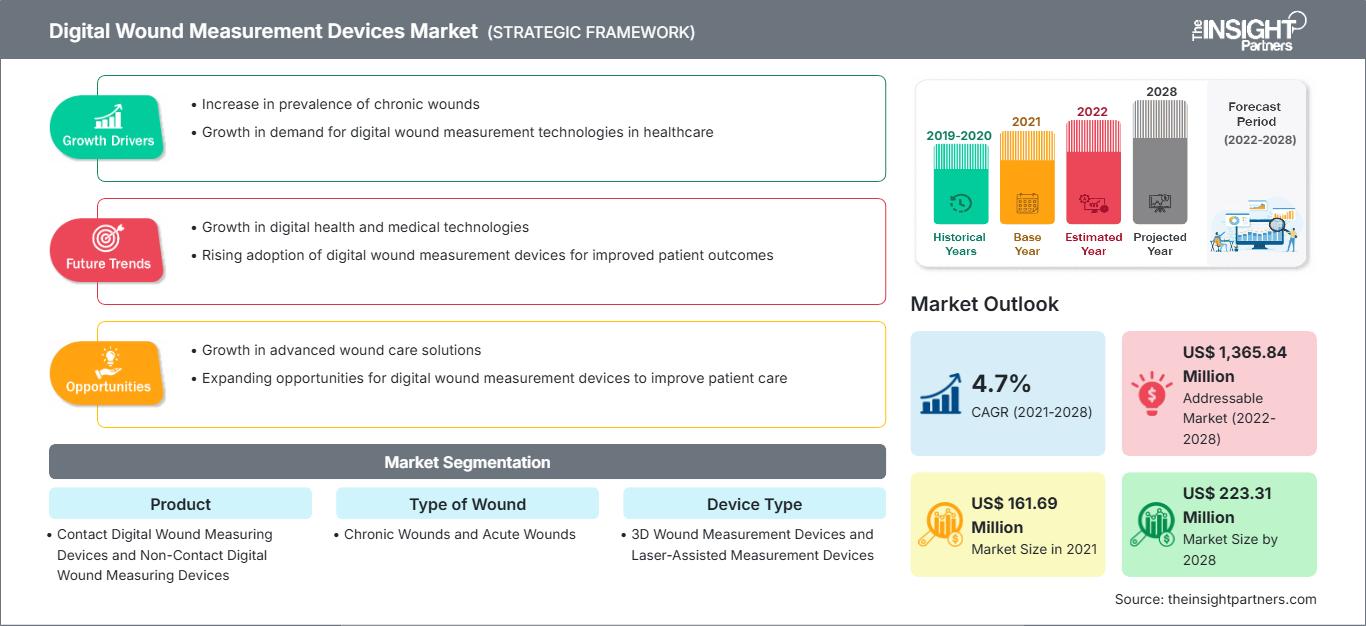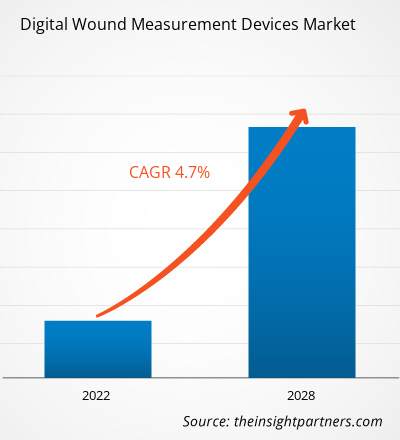[Forschungsbericht]Der Markt für digitale Wundmessgeräte soll von 161,69 Millionen US-Dollar im Jahr 2021 auf 223,31 Millionen US-Dollar im Jahr 2028 wachsen; die durchschnittliche jährliche Wachstumsrate (CAGR) von 4,7 % wird von 2021 bis 2028 geschätzt.
Der Markt für digitale Wundmessgeräte ist nach Produkt, Wundart, Anwendung, Gerätetyp, Endnutzer und geografischer Lage segmentiert. Geografisch unterteilt sich der Markt für digitale Wundmessgeräte grob in Nordamerika, Europa, den asiatisch-pazifischen Raum, den Nahen Osten und Afrika sowie Süd- und Mittelamerika. Der Bericht bietet detaillierte Einblicke in den Markt und betont Parameter wie Markttrends, technologische Fortschritte und Marktdynamik sowie die Analyse der Wettbewerbslandschaft führender Marktteilnehmer.
Passen Sie diesen Bericht Ihren Anforderungen an
Sie erhalten kostenlos Anpassungen an jedem Bericht, einschließlich Teilen dieses Berichts oder einer Analyse auf Länderebene, eines Excel-Datenpakets sowie tolle Angebote und Rabatte für Start-ups und Universitäten.
Markt für digitale Wundmessgeräte: Strategische Einblicke

-
Holen Sie sich die wichtigsten Markttrends aus diesem Bericht.Dieses KOSTENLOSE Beispiel umfasst Datenanalysen, die von Markttrends bis hin zu Schätzungen und Prognosen reichen.
Markteinblicke
Zunehmende Fälle von Magengeschwüren tragen erheblich zum Marktwachstum bei
Die zunehmende Annahme eines ungesunden Lebensstils, Alkoholkonsums und Rauchens trägt zum Anstieg der Prävalenz nicht übertragbarer Krankheiten bei. So gab die Weltgesundheitsorganisation (WHO) im Jahr 2018 an, dass weltweit 13 % der Erwachsenen ab 18 Jahren fettleibig waren. Die USA haben die höchste Fettleibigkeitsprävalenz (~42,4 %), gefolgt von Saudi-Arabien, der Türkei, Ägypten, Libyen, Iran, Irak, Südafrika, Kanada, Mexiko, Australien und vielen südamerikanischen und europäischen Ländern. Darüber hinaus waren im Jahr 2018 34,2 Millionen US-Bürger (10,5 % der Bevölkerung) von Diabetes betroffen. 88 Millionen Menschen leiden an Prädiabetes, der sich unbehandelt innerhalb von fünf Jahren zu Typ-2-Diabetes (T2D) entwickeln kann. Diabetes betrifft etwa 4,2 % der 18- bis 44-Jährigen, etwa 17,5 % der 45- bis 64-Jährigen und etwa 26,8 % der über 65-Jährigen. Die steigenden diabetesbedingten Risiken wie diabetische Fußgeschwüre und Druckgeschwüre führen somit zu einem wachsenden Markt für digitale Wundmessgeräte. Darüber hinaus erhöhen diabetesbedingte Komplikationen wie diabetische Fußgeschwüre (DFU) den Bedarf an fortschrittlichen Produkten zur Wundversorgung. Laut der International Diabetes Federation ist beispielsweise die Wahrscheinlichkeit einer Unterschenkelamputation bei Diabetikern 15- bis 40-mal höher. Bei etwa 85 % aller Amputationen entwickelt sich ein neuropathisches Fußgeschwür. Diese Faktoren treiben daher die Nachfrage nach digitalen Wundmessgeräten im Prognosezeitraum an.
Produktbasierte Erkenntnisse
Basierend auf dem Produkttyp ist der Markt für digitale Wundmessgeräte in berührungslose digitale Wundmessgeräte und digitale Kontakt-Wundmessgeräte unterteilt. Im Jahr 2021 hatte das Segment der berührungslosen digitalen Wundmessgeräte aufgrund des technologischen Fortschritts und der effektiven und berührungslosen Methode der Geräte zur Messung von Wundoberfläche und -volumen einen größeren Marktanteil.
Wundbasierte Erkenntnisse
Basierend auf dem Wundtyp ist der Markt für digitale Wundmessgeräte in chronische und akute Wunden unterteilt. Chronische Wunden werden weiter unterteilt in Dekubitus (PU), diabetische Fußgeschwüre (DFU), venöse Beingeschwüre (VLU) und arterielle Geschwüre. Akute Wunden werden weiter unterteilt in Verbrennungen & Trauma sowie Operationswunden. Das Segment der chronischen Wunden hatte 2021 einen größeren Marktanteil. Dies wird auf die Zunahme chronischer Wunden wie Dekubitus, diabetische Fußgeschwüre, venöse Beingeschwüre und arterielle Geschwüre zurückgeführt.
Gerätetypbasierte Erkenntnisse
Basierend auf dem Gerätetyp ist der Markt für digitale Wundmessgeräte in 3D-Wundmessgeräte und lasergestützte Messgeräte unterteilt. Das Segment der lasergestützten Wundmessgeräte hatte 2021 einen größeren Marktanteil; es wird erwartet, dass im Prognosezeitraum eine höhere CAGR auf dem Markt verzeichnet wird.
Anwendungsbasierte Erkenntnisse
Basierend auf der Anwendung ist der Markt für digitale Wundmessgeräte in Wundversorgung, Gliedmaßenerhaltung und rekonstruktive Chirurgie segmentiert. Das Segment Wundversorgung ist weiter segmentiert in Blutperfusion, hyperbare Sauerstofftherapie, Gewebelebensfähigkeit und andere. Das Segment chronische Wunden hatte 2021 den größten Anteil am Markt für digitale Wundmessgeräte. Es wird jedoch erwartet, dass das Segment Wundversorgung im Prognosezeitraum die höchste CAGR auf dem Markt für digitale Wundmessgeräte verzeichnet.
Endnutzerbasierte Erkenntnisse
Basierend auf dem Endnutzer ist der Markt für digitale Wundmessgeräte in Krankenhäuser & Kliniken und Gemeindezentren unterteilt. Das Segment Krankenhäuser & Kliniken hatte 2021 einen größeren Anteil am Markt für digitale Wundmessgeräte; Es wird erwartet, dass der Markt für digitale Wundmessgeräte im Prognosezeitraum eine höhere durchschnittliche jährliche Wachstumsrate (CAGR) verzeichnet.
Produkteinführungen, Fusionen und Übernahmen sind bei den globalen Akteuren auf dem Markt für digitale Wundmessgeräte weit verbreitete Strategien. Einige der wichtigsten Marktentwicklungen der letzten Zeit sind nachfolgend aufgeführt:
Im September 2021 gab Kent Imaging die Zulassung von SnapshotNIR V3.0 (KD204) durch Health Canada bekannt – jetzt in beiden Amtssprachen lieferbar. Dieses Upgrade bietet erhebliche Funktionserweiterungen der Bildgebungstechnologie, die die Gewebebeurteilung bei akuten und chronischen Wunden verbessern.
Digitale Wundmessgeräte – Marktsegmentierung
Basierend auf dem Produkt ist der Markt für digitale Wundmessgeräte in digitale Kontakt-Wundmessgeräte und berührungslose digitale Wundmessgeräte unterteilt. Je nach Wundtyp ist der Markt in chronische und akute Wunden unterteilt. Das Segment chronische Wunden ist weiter unterteilt in Dekubitus (PU), diabetisches Fußgeschwür (DFU), venöses Beingeschwür (VLU) und arterielle Geschwüre. Das Segment akute Wunden ist weiter unterteilt in Verbrennungen und Traumata sowie Operationswunden. Je nach Gerätetyp ist der Markt für digitale Wundmessgeräte in 3D-Wundmessgeräte und lasergestützte Messgeräte unterteilt. Je nach Anwendung ist der Markt für digitale Wundmessgeräte in Wundversorgung, Extremitätenerhalt und rekonstruktive Chirurgie unterteilt. Das Segment Wundversorgung ist weiter unterteilt in Blutperfusion, hyperbare Sauerstofftherapie, Gewebelebensfähigkeit und Sonstiges. Je nach Endverbraucher ist der Markt für digitale Wundmessgeräte in Krankenhäuser, Kliniken und Gemeindezentren unterteilt. Geografisch ist der Markt hauptsächlich in Nordamerika, Europa, Asien-Pazifik, den Nahen Osten und Afrika sowie Süd- und Mittelamerika unterteilt.
Digitale Wundmessgeräte
Regionale Einblicke in den Markt für digitale WundmessgeräteDie Analysten von The Insight Partners haben die regionalen Trends und Faktoren, die den Markt für digitale Wundmessgeräte im Prognosezeitraum beeinflussen, ausführlich erläutert. In diesem Abschnitt werden auch die Marktsegmente und die geografische Lage digitaler Wundmessgeräte in Nordamerika, Europa, im asiatisch-pazifischen Raum, im Nahen Osten und Afrika sowie in Süd- und Mittelamerika erörtert.
Umfang des Marktberichts über digitale Wundmessgeräte
| Berichtsattribut | Einzelheiten |
|---|---|
| Marktgröße in 2021 | US$ 161.69 Million |
| Marktgröße nach 2028 | US$ 223.31 Million |
| Globale CAGR (2021 - 2028) | 4.7% |
| Historische Daten | 2019-2020 |
| Prognosezeitraum | 2022-2028 |
| Abgedeckte Segmente |
By Produkt
|
| Abgedeckte Regionen und Länder |
Nordamerika
|
| Marktführer und wichtige Unternehmensprofile |
|
Marktteilnehmerdichte für digitale Wundmessgeräte: Auswirkungen auf die Geschäftsdynamik verstehen
Der Markt für digitale Wundmessgeräte wächst rasant. Die steigende Nachfrage der Endverbraucher ist auf Faktoren wie veränderte Verbraucherpräferenzen, technologische Fortschritte und ein stärkeres Bewusstsein für die Produktvorteile zurückzuführen. Mit der steigenden Nachfrage erweitern Unternehmen ihr Angebot, entwickeln Innovationen, um den Bedürfnissen der Verbraucher gerecht zu werden, und nutzen neue Trends, was das Marktwachstum weiter ankurbelt.

- Holen Sie sich die Markt für digitale Wundmessgeräte Übersicht der wichtigsten Akteure
Firmenprofile
- eKare Inc.
- Kent Imaging Inc.
- WoundMatrix Inc.
- Perceptive Solutions
- WoundVision
- Aranz Medical Ltd.
- Tissue Analytics
- Fuel 3D Technologies Ltd.
- Hitachi Aloka Medical America Inc.
- MolecuLight Inc.
- Historische Analyse (2 Jahre), Basisjahr, Prognose (7 Jahre) mit CAGR
- PEST- und SWOT-Analyse
- Marktgröße Wert/Volumen – Global, Regional, Land
- Branchen- und Wettbewerbslandschaft
- Excel-Datensatz
Aktuelle Berichte
Verwandte Berichte
Erfahrungsberichte
Grund zum Kauf
- Fundierte Entscheidungsfindung
- Marktdynamik verstehen
- Wettbewerbsanalyse
- Kundeneinblicke
- Marktprognosen
- Risikominimierung
- Strategische Planung
- Investitionsbegründung
- Identifizierung neuer Märkte
- Verbesserung von Marketingstrategien
- Steigerung der Betriebseffizienz
- Anpassung an regulatorische Trends






















 Kostenlose Probe anfordern für - Markt für digitale Wundmessgeräte
Kostenlose Probe anfordern für - Markt für digitale Wundmessgeräte